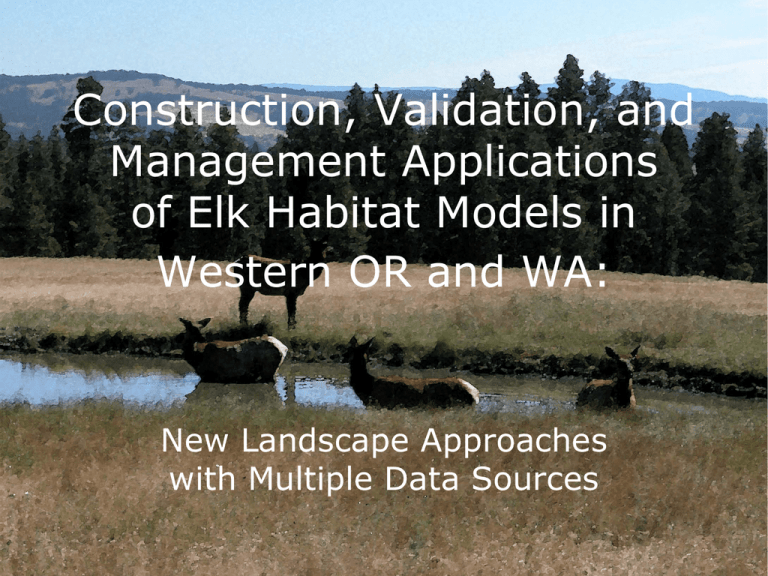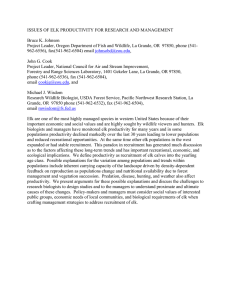Construction, Validation, and Management Applications of Elk Habitat Models in
advertisement

Construction, Validation, and Management Applications of Elk Habitat Models in Western OR and WA: New Landscape Approaches with Multiple Data Sources Modeling Team: Jennifer Boyd Priscilla Coe John Cook Rachel Cook Greg Davidson Ray Davis Bill Gaines Justin Hadwen Bruce Johnson John Lehmkuhl Bridgett Naylor Ryan Nielson Peter Singleton Scott McCorquodale Rob McCoy Mary Rowland David Vales Marty Vavra Mike Wisdom Additional thanks to: Scott Harris, Washington Dept. of Fish & Wildlife Chris Danilson, Sauk-Suiattle Indian Tribe Frank Geyer, Quileute Tribe Eric Cole, National Elk Refuge Dewaine Jackson & Mike Pope, Oregon Dept. of Fish & Wildlife Bob Anthony, Oregon St. Univ. Dana Sanchez, Oregon St. Univ. Partners (Staffing, Funding, or Data) Boone and Crockett Club Lower Elwha Klallam Tribe Makah Nation Muckleshoot Indian Tribe National Council for Air and Stream Improvement National Fish and Wildlife Foundation Oregon Department of Fish and Wildlife Oregon State University Partners (Staffing, Funding, or Data) Quileute Tribe Rocky Mountain Elk Foundation Sauk-Suiattle Indian Tribe Sporting Conservation Council USDA Forest Service USDI Bureau of Land Management Washington Department of Fish and Wildlife WEST, Inc. Presentation Background & Need for Elk Habitat Models Modeling Objectives Topics Addressed in Presentations Today Background and Need R. Cook Elk Habitat Models—Who Cares? Elk compose a multimillion dollar economy in the western U.S. (hunting, viewing, damage). Elk distribution and abundance across landscapes, and thus the species’ economic impacts across land ownerships, can be directly controlled through management. Elk Habitat Models—Who Cares? Elk are an “early-seral” species whose needs are compatible with active silviculture. Other “early-seral” species may benefit from habitat management for elk. Public land use plans continue to feature elk and elk management. Background and Need Models developed in 1970s & 80s with limited empirical data. Empirical data restricted to single variable habitat relations with elk. Contributions of multiple variables to predict relative probability of elk use not empirically-based (e.g., geometric mean); resource selection modeling not yet developed. 1986 Westside Model Size & Spacing of Cover & Forage Areas Density of Open Roads Cover Quality Forage Quality Habitat effectiveness = geometric mean of the 4 covariates Why New Elk Habitat Models? “Old” models still in use but structure and some components outdated (e. g., thermal cover) Data from many radiotelemetry studies now available for new modeling approaches. Data on elk nutritional resources now available for modeling at landscape scales. Modeling Work: • Summer range (June 1-Aug. 31) • Landscape extents (>50,000 ac) • Regional Inference Space • Non-hunting periods (but populations are hunted) • Female elk Objectives 1. Build a nutrition model that predicts nutritional resource values (e.g., dietary digestible energy) for elk across all landscape conditions on summer range. 2. Build and validate a set of plausible, competing resource selection models that predict the probability of elk use at landscape extents on summer range. Objectives 3. Include nutrition model predictions as a covariate in resource selection models. 4. Include additional human disturbance and physical covariates that potentially affect or account for the probability of elk use of nutritional resources. Objectives 5. Use data from multiple study areas (diverse environments & land ownerships) to construct, select, and validate models. Objectives Two predictions of primary interest: 1. Composition (percent area) of a landscape by nutritional condition (e.g., excellent, good, marginal, poor) —Nutrition Model Objectives Two predictions of primary interest: 2. Probability of elk use of a landscape, given all covariates that affect use —Resource Selection Model. Objectives Two management options of primary interest: 1. Degree to which management can change landscape area by nutritional condition (Nutrition Model). 2. Degree to which management can change the probability of elk use, given all major factors that affect use (Resource Selection Model). Presentations Nutrition Modeling: John Cook Telemetry Data: Priscilla Coe Spatial Data: Bridgett Naylor Resource Selection Methods: Ryan Nielson Resource Selection Results: Mary Rowland Management Applications: Mike Wisdom Nutrition Model • % Canopy Cover • % Hardwoods • Potential Natural Vegetation Zone Dietary Digestible Energy (DDE) Resource Selection Model • DDE • Dist. to Public Roads • % Slope • Dist. to Edge Probability of Elk Use Nutrition Model Resource Selection Model • % Canopy Cover • DDE • % Hardwoods • Dist. to Public Roads • Potential Natural • % Slope Vegetation Zone Dietary Digestible Energy (DDE) • Dist. to Edge Probability of Elk Use Nutrition Modeling: John Cook Spatial Data: Bridgett Naylor Nutrition Model • % Canopy Cover • % Hardwoods • Potential Natural Vegetation Zone Dietary Digestible Energy (DDE) • Telemetry Data: Priscilla Coe • Spatial Data: Bridgett Naylor • Methods: Ryan Nielson • Results: Mary Rowland Resource Selection Model • DDE • Dist. to Public Roads • % Slope • Dist. to Edge Probability of Elk Use Management Applications: Mike Wisdom Nutrition Model Resource Selection Model • %Canopy Cover • DDE • % Hardwoods • Dist. to Public Roads • Potential Natural • % Slope Vegetation Zone Dietary Digestible Energy (DDE) • Dist. to Edge Probability of Elk Use Caveats Results are preliminary. Purpose of workshop is to share current results and obtain feedback about the scientific rigor and management utility of “best” model(s). Finalizing Model(s) Help needed from biologists to test and evaluate management utility of models. Westside modeling process will be finished in the coming months and an additional workshop held by early next year. Discussion Session Tuesday, April 20, 8 am-noon, same location. Obtain feedback about scientific and management utility of “best” model(s). Break-out groups will address specific questions about management uses.






